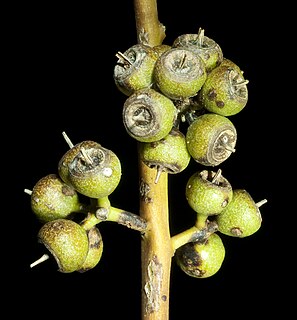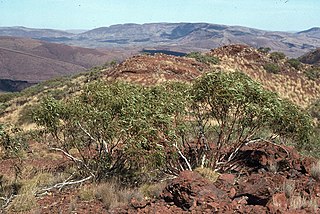Eucalyptus zopherophloia, commonly known as the blackbutt mallee, is a species of spreading mallee that is endemic to an area on the west coast of Western Australia. It has rough bark over part or all of the trunk, smooth grey bark above, narrow lance-shaped leaves, flower buds in groups of nine or eleven, creamy white flowers and conical fruit.

Eucalyptus argutifolia, commonly known as Wabling Hill mallee or Yanchep mallee, is a mallee that is endemic to the south-west of Western Australia. It is a rare species with smooth bark, lance-shaped adult leaves, flower buds arranged in groups of seven or nine, white flowers and cylindrical to conical cup-shaped fruit.

Eucalyptus apiculata, commonly known as the narrow-leaved mallee ash and is a mallee that is endemic to New South Wales. It has smooth white or greyish bark, narrow lance-shaped adult leaves, flower buds in groups of three to seven, white flowers and urn-shaped or barrel-shaped fruit.

Eucalyptus aquilina, commonly known as the Mount Le Grand mallee, is a mallee that is endemic to a small area in the south-west of Western Australia. It has smooth white and grey bark, lance-shaped, often curved leaves, top-shaped or diamond-shaped flower buds, white to cream-coloured flowers and cone-shaped fruit on a down-curved peduncle.

Eucalyptus effusa, commonly known as rough-barked gimlet, is a species of mallee or small tree that is endemic to Western Australia. It has thin, rough bark on the base of the trunk, smooth bark above, linear to narrow lance-shaped adult leaves, flower buds arranged in groups of seven, white flowers and cup-shaped to conical fruit.

Eucalyptus latens, commonly known as narrow-leaved red mallee, is a species of mallee that is endemic to the south-west of Western Australia. It has smooth grey and coppery bark, linear to narrow lance-shaped adult leaves, flower buds in groups of seven to eleven or more, creamy white flowers and small barrel-shaped to shortened spherical fruit.
Eucalyptus litorea, commonly known as saline mallee, is a species of mallee that is endemic to a small area on the southern coast of Western Australia. It has hard, rough grey bark on the trunk, smooth grey bark above, lance-shaped adult leaves, flower buds in groups of seven, white flowers and cylindrical or barrel-shaped fruit.
Eucalyptus olivina is a species of mallee or a tree that is endemic to Western Australia. It has smooth greyish bark, linear to narrow lance-shaped adult leaves, flower buds in groups of seven or nine, creamy white flowers and short barrel-shaped to cup-shaped fruit.

Eucalyptus petrensis, commonly known as limestone mallee, straggly mallee or koodjat, is a species of straggly mallee that is endemic to Western Australia. It has mostly smooth bark, lance-shaped adult leaves, flower buds in groups of between seven and thirteen, creamy white flowers and more or less spherical fruit.

Eucalyptus phaenophylla, also known as common southern mallee, is a species of mallee that is endemic to Western Australia. It has smooth bark, linear to narrow lance-shaped or narrow elliptical adult leaves, flower buds in groups of up to thirteen, pale lemon-coloured flowers and barrel-shaped, cylindrical or conical fruit.

Eucalyptus pilbarensis is a species of mallee or low shrub that is endemic to the Pilbara region of Western Australia. It has smooth, white or greyish bark, lance-shaped to curved adult leaves, flower buds in groups of seven, white flowers and conical, barrel-shaped or cylindrical fruit.
Eucalyptus polita is a species of mallet or small tree that is endemic to the southwest of Western Australia. It has smooth, greyish bark, narrow lance-shaped adult leaves, flower buds in groups of between seven and eleven, white flowers and cup-shaped fruit.
Eucalyptus prominens is a species of mallee that is endemic to a small area on the west coast of Western Australia. It has smooth greyish bark, sometimes with rough bark near the base, lance-shaped adult leaves, flower buds in groups of seven or nine, white flowers and conical fruit.
Eucalyptus semota, commonly known as marymia mallee, is a species of mallee or small tree that is endemic to a small area in central Western Australia. It has rough, flaky to fibrous bark on the trunk, smooth grey or brown bark above, linear to narrow lance-shaped leaves, flower buds in groups of seven or nine, white flowers and conical to cup-shaped fruit.

Eucalyptus sporadica, commonly known as the Burngup mallee, is a species of mallee that is endemic to the southwest of Western Australia. It has smooth bark, lance-shaped adult leaves, flower buds in groups of seven, yellowish flowers and down-turned, conical to cylindrical fruit.
Eucalyptus subangusta is a species of tree, mallee or mallet that is endemic to the southwest of Western Australia. It has smooth bark, narrow lance-shaped leaves, flower buds in groups of up to nineteen, white flowers and cup-shaped to barrel-shaped fruit.

Eucalyptus suberea, commonly known as Mount Lesueur mallee or cork mallee, is a species of mallee or a small tree that is endemic to a small area on the west coast of Western Australia. It has rough bark on some or all of the trunk, smooth white bark above, lance-shaped adult leaves, flower buds in groups of eleven to twenty or more, white flowers and shortened spherical fruit.
Eucalyptus subtilis, commonly known as narrow-leaved mallee, is a species of mallee that is endemic to Western Australia. It has smooth bark, linear adult leaves, flower buds in groups of nine or eleven, cream-coloured flowers and usually cup-shaped fruit.
Eucalyptus vegrandis, commonly known as the Ongerup mallee, is a species of mallee that is endemic to the south-west of Western Australia. It has smooth bark, linear to lance-shaped adult leaves, flower buds in groups of seven, creamy white flowers and cup-shaped or conical fruit.
Eucalyptus × missilis, commonly known as bullet bush, is a species of mallee that is endemic to a small area on the south coast of Western Australia. It has smooth bark, egg-shaped to lance-shaped adult leaves, flower buds in groups of between seven and fifteen, pale yellow flowers and cup-shaped to cylindrical fruit. It is thought to be a hybrid between E. cornuta and E. angulosa that occur in the same area.










